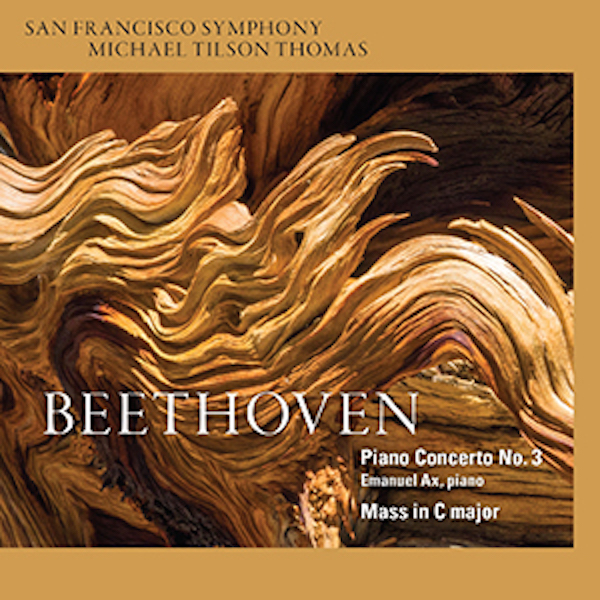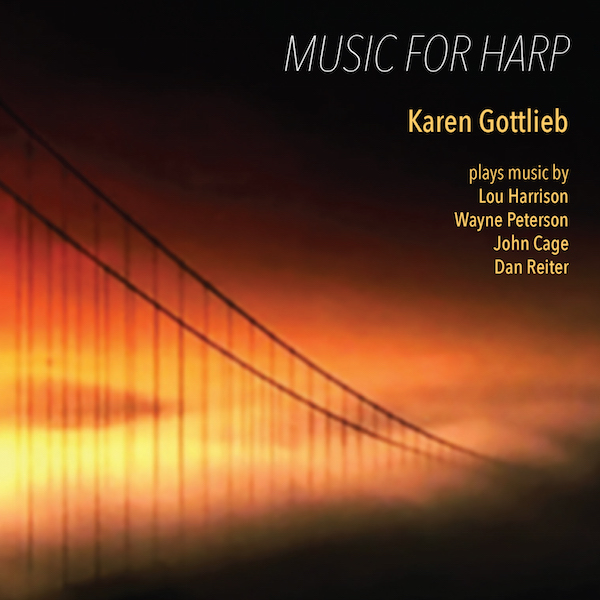Classical Album Reviews: Beethoven’s Piano Concerto no. 3 and Mass in C (SFS Media), Music for Harp (Innova)
We have something of a mixed success here. Beethoven’s Mass in C is the highlight: grand, enthusiastic, and dramatic. Would that the San Francisco Symphony’s performance of the Third Concerto possessed sharper edges and more electricity.

By Jonathan Blumhofer
It’s not necessarily repertoire you automatically associate with the San Francisco Symphony (SFS) and their music director, Michael Tilson Thomas, but, over the last couple of years, the team has embarked on a recorded cycle of Beethoven symphonies, concerti, and assorted other works, the most recent installment of which is this album featuring the C-minor Piano Concerto (with Emmanuel Ax) and the Mass in C. Whether or not we really need another recording of Beethoven’s only minor-key piano concerto is an open question, but the Mass certainly has some appeal and, from a technical angle, the playing and singing of the forces in both works are virtually unimpeachable.
On the plus side, this reading of the Piano Concerto no. 3 doesn’t shy away from the Mozartian quality of Beethoven’s approach: Ax’s playing is graceful, lyrical, and, especially over the closing pages of the finale, winsome and sprightly. The melodic line is always front and center and, whenever Beethoven offers a tune, Ax makes the most of it: he spins out a lovely second movement and the lyrical bits in the outer movements sing with his trademark clarity. The SFS, too, sounds beautiful throughout, playing with rounded tone, keen attention to phrasing, and uniform articulation. Tempos are about average, balances are finely judged, and there are a handful of fine individual moments from members of the orchestra (including some driving timpani thwacks in the finale) to boot.
But, as an interpretation, this doesn’t add much to what’s already out there. The execution of the score sounds lovely to be sure, but there’s too much gentility in everybody’s playing, and that approach has the effect of enervating the music’s latent drama, especially in the big first movement. Listen to Rubinstein, Argerich, Brendel, Uchida, or Zimmerman in this concerto and you’ll find poetry matched with muscle; here, the former is present but there isn’t enough of the latter. While things improve a bit in the last two movements, the whole performance, to these ears, comes across too “soft” and kinetically lacking.
Happily, these problems aren’t apparent in the reading of the Mass in C, in which the SFS is joined by the SFS Chorus and a strong quartet of soloists. To call this Mass a masterpiece is, perhaps, to gild the lily just a bit: it lacks both the spiritual and musical depth of the later Missa solemnis and boasts not a few moments in which Beethoven seems to be spinning his wheels (as at the end of the “Gloria,” in which he attempts, but doesn’t quite succeed, to outdo Haydn).
But it does have much to offer. There’s a theatrical quality to much of Beethoven’s writing in the piece, oftentimes involving the alternation of soloists and chorus. The music is often simply quite charming, too, not an adjective always directed at Beethoven’s music of this period. And, while there are certainly moments that go on for too long, there’s a powerful, almost cinematic, quality to the way Beethoven allows the musical drama to unfold, culminating in a truly moving setting of the “Agnus Dei.”
In general, the writing for voices is much friendlier and more approachable in this Mass than what we find in Beethoven’s later choral music (notably the Missa and Ninth Symphony). And the SFS Chorus, ably prepared by its director, Ragnar Bohlin, sings with fervent warmth and excellent diction. They easily navigate the music’s many unexpected harmonic detours and sing with a ruddy confidence that allows the piece’s most over-long bits to pass by excitingly (such as the lengthy fugue on “Cum sancto spiritu” that closes the “Gloria”). The four soloists – Joélle Harvey, Kelley O’Connor, William Burden, and Shenyang – match the choral forces in both intensity and fullness of tone. So well do the vocal forces capture the spirit of Beethoven’s writing that it’s simply a treat to hear both groups playing off of one another as their parts intersect throughout the Mass.
Again, the SFS sounds wonderful. Here, the sunniness of their textures and the lightness of the orchestra’s collective touch fits the music much better than in the C-minor Concerto. MTT presides over it all smartly, letting the music unfold at a natural pace and not overemphasizing its several quirky moments. There’s a real depth of feeling to the “Kyrie” and “Agnus Dei;” the outer sections of the “Sanctus” and various junctures in the “Credo” are rhythmically alive; and the “Gloria,” even if it’s not as visionary as the one to come in the later Missa, is quite exultant.
So we have something of a mixed success here. The Mass is, without a doubt, the highlight: grand, enthusiastic, and dramatic. Would that this performance of the Third Concerto possessed sharper edges and more electricity. But what can you do?
*****

“Flaky composers spawn in California,” Nicolas Slonimsky told us in his memoir, Perfect Pitch. But there’s little evidence of that phenomenon in Karen Gottlieb’s enticing new album, Music for Harp by Bay-area composers. Quite the contrary: there’s plenty to haunt here, including a dulcet account of Lou Harrison’s gorgeous Suite for Cello and Harp and a compelling performance of Wayne Peterson’s extended-technique-laden Colloquy for flute and harp. In the latter, Gottlieb, who’s regularly performed with the SFS for more than thirty years, is joined by Tod Brody, whose clarity of tone and pristine, confident navigation of Peterson’s demanding writing for flute is one of the disc’s highlights.
Indeed, there really isn’t much not to like here, especially as the track list, which includes additional pieces by Dan Reiter and John Cage, reads like one of the SFS’s American Mavericks festivals. What’s perhaps most striking isn’t the sheer stylistic breadth Gottlieb and her fellow musicians cover, but the many strands – extended techniques, scales borrowed from Asian and Indian music, and so on – that tie these disparate works together.
Certainly, if your impression of Cage is only drawn from his most experimental scores and ideas, In a Landscape, a sumptuous, elegiac meditation for solo harp will stand as a revelation. Gottlieb teases out the lyricism in its pages, plumbing a sort of mystic depth not far removed from Debussy – or Harrison, for that matter. A similar timelessness pervades Reiter’s Sonata for flute and harp, which Gottlieb and Brody treat almost like a Liszt rhapsody: flexible in tempo, songful and evocative, spirited and mysterious in affect. It’s a gripping performance and a fine piece, one whose constantly shifting moods and gestures suggests the fleeting glimpse of an elusive spirit.
Music for Harp begins and ends with pieces by Harrison, whose singular thinking about music synthesized Eastern and Western scales and forms. There’s a certain sameness between the aforementioned Suite and the Music for Harp with Percussion, in part because Gottlieb elected to play the latter to equal-tempered tuning rather than Harrison’s suggested “just intonations.” At any rate, the performances are excellent. The Suite really sings in Gottlieb and Reiter’s hands (he’s an excellent cellist as well as composer), especially its fourth movement “Aria.” In Music for Harp with Percussion, Gottlieb is joined by William Winant and Daniel Kennedy, whose playing adds exotic flavor to their respective movements. Throughout, Gottlieb’s way with the music is sure and even-handed: it sings and dances in equal measure. In this piece and across this album, she’s compiled an inviting account of some underrepresented repertoire and more than done it justice.
Jonathan Blumhofer is a composer and violist who has been active in the greater Boston area since 2004. His music has received numerous awards and been performed by various ensembles, including the American Composers Orchestra, Kiev Philharmonic, Camerata Chicago, Xanthos Ensemble, and Juventas New Music Group. Since receiving his doctorate from Boston University in 2010, Jon has taught at Clark University, Worcester Polytechnic Institute, and online for the University of Phoenix, in addition to writing music criticism for the Worcester Telegram & Gazette.

My Dear Jonathan:
Your review of Music for Harp was salutary, but please!!!! Harrison’s Harp music was performed in *equal* temperament, not ‘well-temperament’ which is a divine unequal Baroque temperament used for at least a century before it was replaced by modern equal temperament. You may enjoy hearing those pieces played in Lou’s preferred “Just Intonations” on the new album Just Strings from MicroFest Records, that also presents a second Suite of tuned harp music that was discovered after the composer’s passing.
Keep up the good work….
Thanks, John – that’s completely my error. Will fix.
Thanks for the encouraging words — the correction has been made.